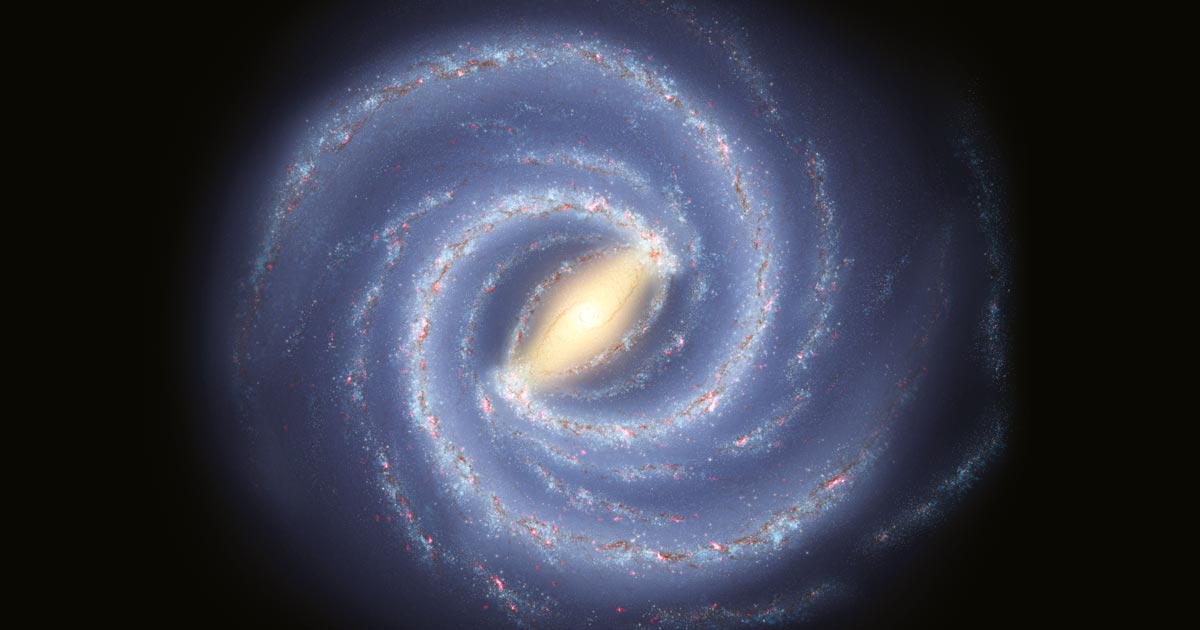Hidden from the field of vision of an observer located on Earth by the huge concentration of stars, gas, and dust that make up the bulge of the Milky Way, a superstructure composed of 58 unknown galaxies has been identified by a team of astrophysicists from Argentina, Brazil, and Chile. The galaxies appear to be part of a block of more or less compact material, located in a small region of space at a distance approximately 2.2 billion light years from Earth.
The clue that this cluster of galaxies may exist was provided by data from the Vista Variables in Via Lactea (VVV) survey, a project conducted by the European Southern Observatory (ESO), based in Chile, which mapped the area next to the bulge of the galaxy, where intense formation of stars occurs, in frequencies of infrared. “I began working with data from VVV in 2017 and, since the beginning, noticed that there was a concentration of objects in a small area of the sky,” says astrophysicist Daniela Galdeano, who is doing a PhD at the National University of San Juan, in Argentina, lead author of the study published in January in the scientific journal Astronomy & Astrophysics.
Galdeano and her collaborators chose five objects within this region to study in more depth and try to confirm if they really were galaxies, as they suspected. To begin with, they wanted to take measurements in the area of spectroscopy on these five objects. The method allows the astrophysicists to measure the emission and absorption of different wavelengths of electromagnetic radiation by the celestial bodies. From this type of information, they can infer their properties, such as temperature, chemical consistency, and mass.

Daniela GaldeanoImage indicates the approximate location of 5 of the 58 identified galaxies behind the zone of avoidance of the Milky WayDaniela Galdeano
The first name that Galdeano thought of to do this complementary study was that of a Brazilian colleague, astrophysicist Rogério Riffel, from the Federal University of Rio Grande do Sul (UFRGS), whose presentation she had seen about spectroscopy. The partnership went ahead and the team managed observation time on the spectrograph of one of the Gemini Observatories, the south telescope, located in Chile. Brazil and Argentina are partners of the Gemini, along with the USA, Canada, and South Korea. “This way, we were able to confirm that these objects were really galaxies and were part of a bigger structure,” says Riffel, who is also coauthor of the article.
Zone of avoidance
The cluster with 58 galaxies is located in an area of the sky called the zone of avoidance or exclusion. The definition of this region comes from the point of view of an observer within the Solar System, more precisely on Earth, who is looking at the center of the Milky Way. The view of what is behind the bulge of the galaxy is hidden by a large concentration of stars, gas, and dust in this region. Therefore, from the field of view of a terrestrial observer, everything is obscured by the presence of the Milky Way, especially its bulge, and falls within the zone of exclusion. It covers both what is on the “other side” of the galaxy, still within the limits of the Milky Way, as well as celestial objects outside it but located in that direction of the field of view. Between 10% and 20% of the sky seen from Earth is within the zone of avoidance.
Visible light cannot pass regions rich in gases and stardust. It is absorbed and scattered upon encountering this type of material in its path, limiting its use as an observational tool in this field. “Because of this, the new cluster of galaxies cannot be seen in visible light, with an optical telescope,” explains Riffel. But certain frequencies of infrared, such as those used by the VVV survey, are less affected by the high concentrations of gas and dust and could be useful for discovering previously unknown objects in the region of exclusion.
This is not the first time that galaxies or new structures have been located in the zone of avoidance. Perhaps the most famous and mysterious of them is the Great Attractor, a gigantic concentration of mass the size of tens of thousands of galaxies, about 150 million light years from Earth. Identified in 1986, the Great Attractor (invisible in the optical field) acts as a type of space magnet. Its huge gravitational force pulls the Milky Way and other galaxies in the direction of the constellations of Hydra and Centaurus. “Although the cluster with 58 galaxies is not as massive as the Great Attractor, its discovery in the zone of avoidance is important for the studies of the local Universe,” says astrophysicist Roberto Saito, of the Federal University of Santa Catarina (UFSC), who took part in the VVV survey, but is not one of the authors of the new work.
Scientific article
GALDEANO, D. et al. Unveiling a new extragalactic structure hidden by the Milky Way. Astronomy & Astrophysics. vol. 669. jan. 2023.


